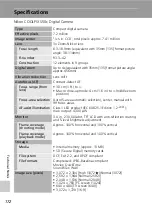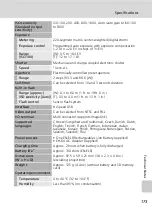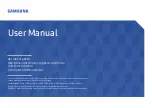
158
Caring for the Camera
Te
chnica
l Note
s
j
The Self-Timer Lamp/AF-Assist Illuminator LED
The light-emitting diode (LED;
timer lamp/AF-assist illuminator conforms to the following
IEC standard:
k
The Battery
• Check the battery level when taking the camera out and charge the battery if necessary
16). Do not continue charging once the battery is fully charged, as this will result in
reduced battery performance. If possible, carry a fully charged spare battery when taking
pictures on important occasions.
• Do not use the battery at ambient temperatures below 0 °C (32 °F) or above 40 °C
(104 °F). During charging, the temperature should be in the vicinity of 5 to 35 °C (41 to
95 °F). Note that the battery may become hot during use; wait for the battery to cool
before charging. Failure to observe these precautions could damage the battery, impair its
performance, or prevent it from charging normally.
• On cold days, the capacity of batteries tends to decrease. Be sure that the battery is fully
charged before heading outside to take pictures in cold weather. Keep spare batteries in a
warm place and exchange as necessary. Once warmed, a cold battery may recover some of
its charge.
• Dirt on the battery terminals can prevent the camera from functioning.
• When the battery is not in use, remove it from the camera or battery charger and replace
the terminal cover. The camera and battery charger draw minute amounts of current even
when off; if left in place, the battery could be drained to the point that it no longer func-
tions. Turning the camera on or off while the battery is exhausted can result in reduced bat-
tery life. If the battery will not be used for an extended period, store it in a cool (15 to
25 °C / 59 to 77 °F), dry place. Recharge it at least once a year and run it flat before return-
ing it to storage.
• Replace the battery when it no longer holds a charge. Used batteries are a valuable
resource. Please recycle used batteries in accordance with local regulations.
















































